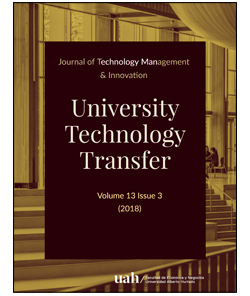Organizational Ambidexterity: A study in Brazilian Higher Education Institutions
DOI:
https://doi.org/10.4067/S0718-27242018000300036Keywords:
Innovation management, Organizational ambidexterity, Higher education institutions.Abstract
The purpose was to understand how the ambidexterity degree (exploration + exploitation actions) can explain the variance of the number of students. As theoretical foundation, it was considered the arguments proposed by March (1991) and Tuschman and O’Reilly III (2004) about organizational ambidexterity (balance of incremental and radical innovation initiatives). About the methodology, a quantitative approach was used, and the sample counted with 79 executives of higher education institutions (HEI). For data analysis, descriptive statistics, chi-square, cluster analysis, correlation analysis and multiple linear regression were used. As outcome, the confirmation that ambidexterity can explain variance of the number of students in 20.6%. However, it was also observed that it cannot explain variation of the main index of teaching quality: General Course Index. Finally, there is a proposition of a maturity degree for ambidexterity, subdivided into four levels: I - Embryonic, II - Structured, III - Semi-developed and IV - Developed.Downloads
References
Bierly, P. E.; Daly, P. S. (2007) Alternative knowledge strategies, competitive environment, and organizational performance in small manufacturing firms. In Entrepreneurship Theory and Practice .pp. 493-516. https://doi.org/10.1111/j.1540-6520.2007.00185.x
Ministério da Educação. Instituto Nacional de Estudos e Pesquisas Educacionais Anísio Teixeira. (2015). Censo da Educação Superior 2013: resumo técnico. Brasília.
Cooper, D. R; Schindler, P. S. (2003). Métodos de pesquisa em administração. Porto Alegre: Bookman.
Dancey, C. P.; Reidy, J. (2006). Estatística sem matemática para psicologia: usando SPSS para Windows. 3. ed. Porto Alegre: Artmed.
Fávero, L.P.; Belfiore, P.; Silva, F.L.; Chan, B.L. (2009). Análise de dados: modelagem multivariada para tomada de decisões. 5. ed. Rio de Janeiro: Campus / Elsevier.
Lubatkin M. H.; Simsek, Z. Y.; Veiga, J. F. (2006). Ambidexterity and performance in small-to medium-sized firms: the pivotal role of top management team behavioral integration. Journal of Management, 32, 646-672. https://doi.org/10.1177/0149206306290712
March. J. (1991). Exploration and exploitation in organizational learning. Organization Science, 2. 71-87. https://doi.org/10.1287/orsc.2.1.71
Marôco, J. (2014) Análise de equações estruturais: fundamentos teóricos, software & aplicações. 2. ed. Pêro Pinheiro: Cafilesa.
Marôco, J. (2016) Teaching notes. Portugal.
Martins, G. A; Theóphilo, C. R. (2009) Metodologia da investigação científica para ciências sociais aplicadas. São Paulo: Atlas.
Nascimento, T. C.; Cherobim, A. P. M. S.; Mendonça, A. T. B. B. (2013) Escalas de capacidade inovadora: uma revisão sobre proposições para avaliação de ambidestralidade em organizações. XXXVII Encontro da ANPAD, Rio de Janeiro.
O’reilly, C. A; Tuschman, M. L. (2004). The ambidextrous organization. Harvard Business Review, 82(4). 78-81.
OCDE Organização de Cooperação e Desenvolvimento Econômico. (2017, July, 18). Manual de Oslo: Diretrizes para a coleta e interpretação de dados sobre inovação. 3. Ed. [online]. From http://www.finep.gov.br/images/apoio-e-financiamento/manualoslo.pdf
Perez, C. (2004) Revoluções tecnológicas, troca de paradigmas e mudanças sócio institucionais. In: Reinert, E. (Ed.) Globalization, economic development and inequality: an alternative perspective. ( pp. 217-242). Cheltenham, UK and Northampton, USA: Edward Elgar.
Popadiuk, S. (2015). Exploração, explotação e ambidestria: inovação para a geração de valor. São Paulo: Mackenzie.
Reis, D.; Carvalho, H. G. R.; Cavalcante, M. B. (2011) Gestão da inovação. Curitiba: Aymará.
Scandelarli, V. R. N. (2011) Inovação e sustentabilidade: ambidestralidade e desempenho sustentável na indústria eletroeletrônica. Dissertation (Doctorship). Universidade Federal do Paraná - UFPR.
Scandelarli, V. R. N; Cunha, J.C. (2013) Ambidestralidade e Desempenho Socioambiental de Empresas do Setor Eletroeletrônico. RAE, São Paulo, v. 53, n. 2, mar.-abr. 183 – 198.
Schumpeter, J. A. (1985) Teoria do desenvolvimento econômico. São Paulo: Nova Cultural.
Tushman, M. L; O’reilly, C. A. (1996). Ambidextrous organizations: managing evolutionary and revolutionary change. California Management Review. https://doi.org/10.2307/41165852
Downloads
Published
How to Cite
Issue
Section
License
Copyright (c) 2018 Journal of Technology Management & Innovation

This work is licensed under a Creative Commons Attribution-ShareAlike 4.0 International License.







